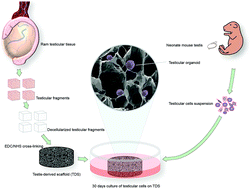A testis-derived macroporous 3D scaffold as a platform for the generation of mouse testicular organoids†
Abstract
Extracellular matrix-derived scaffolds provide an efficient platform for the generation of organ-like structures. Successful development of testicular organoids (TOs) with the capability of supporting complete spermatogenesis has not been reported yet. Here, we have developed an optimized method for the decellularization of ram testicular tissue fragments. Our findings showed that testicular fragments treated with a serial combination of Triton X-100 and SDS in PBS for 48 h resulted in the efficient removal of cellular materials and retention of the extracellular matrix (ECM) components. In order to fabricate testis-derived scaffolds (TDSs), the testicular ECM (T-ECM) was digested in acid/pepsin, followed by neutralization of pre-gel solution to form a hydrogel. Then, the hydrogels were freeze-dried and cross-linked using a chemical method. To reach the optimal concentration for the T-ECM in the fabrication of TDSs, the scaffold properties including porosity, pore size, swelling behavior, and degradation were evaluated. Our study suggested that 25 mg ml−1 of the T-ECM is the best concentration for the fabrication of macroporous TDSs for demonstrating lower pore size, homogeneously distributed pores, and a higher swelling ratio. Furthermore, inoculation of neonatal mouse testicular cells onto TDSs resulted in the generation of multicellular TOs in which the differentiation of spermatogonial cells into post-meiotic cells was confirmed. Hormonal analysis of TDSs revealed the functionality of TOs in the secretion of testosterone and inhibin B. The current study also demonstrated that macroporous TDSs could provide a novel platform for testicular tissue engineering and in vitro spermatogenesis.



 Please wait while we load your content...
Please wait while we load your content...